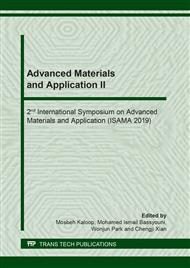p.82
p.88
p.94
p.100
p.109
p.116
p.122
p.128
p.134
Predictive Study of Combustion Temperature of Liquefied Petroleum Gas (LPG) on the Spherical Packed-Bed Porous Burner
Abstract:
The relation between the significant factors and the combustion temperature (T) of Liquid Petroleum Gas (LPG) on the spherical packed-bed porous burner is investigated. Alumina-Cordierite ceramic balls having the average diameter (d) of 3 mm. and the porosity (ε) of 0.322 are employed as porous media. The multiple-linear and multiple-quadratic regressions are used to analyze the data at the equivalence ratio (F) of 0.58 – 0.66 and volumetric premixed-gas flow rate (Vmix) in a range of 10 – 25 m3/h. The porous thickness (H) is in the range of 2.5 – 7.5 cm. Thus, independent variables are F, Vmix and H. The dependent variable is the maximum temperature (T) of combustion LPG on the porous burner. For statistical analysis, both main and interaction of independent variables effecting to the combustion temperature are investigated. The results showed that, for the case of multiple-linear regression, an equations recommended in prediction of the T on porous burner is T = 1375.603(F) +179.636(H) – 295.028(FH) – 9.628(HVmix) + 16.368(FVmixH) with a coefficient of determination (R2) of 0.998 and the standard error of the estimation of 42.7365. In the case of multiple- quadratic regression, a proper equation used in predicting T on porous burner is T = 2133.184(F)2 + 1.247(Vmix)2 + 17.248(H)2 – 2.916(FVmix )2 – 42.107(FH)2 – 0.049(VmixH)2 + 0.123(FVmixH)2 with R2 of 0.997 and standard error of the estimation of 44.2979. In addition, the comparison between the experimental results and the predicted estimation is reported that different percentage of both regressions and experimental results is satisfied.
Info:
Periodical:
Pages:
109-115
Citation:
Online since:
June 2019
Authors:
Price:
Сopyright:
© 2019 Trans Tech Publications Ltd. All Rights Reserved
Share:
Citation:


